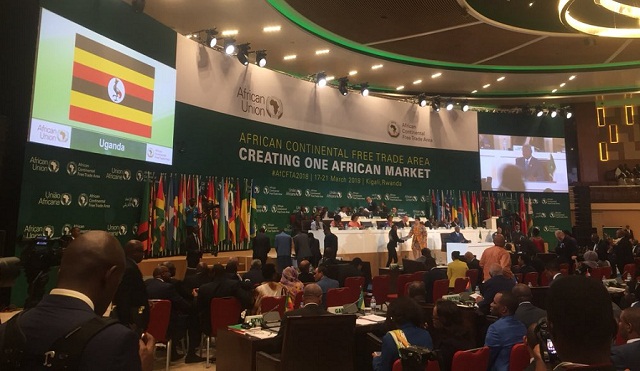
Significant reduction or elimination of tariffs would boost intra-Africa trade to more than 50%
COMMENT | DAMALI SSALI | There are several factors that influence the value and volume of trade. However, tariffs on tradeable goods and services are one of the most significant.
International trade grew dramatically in the second half of the 20th century. As an example, total global trade in 2000 was 22 times greater than it had been 1950.
This increase in multilateral international trade occurred when trade barriers, especially tariffs, were significantly reduced or in some cases eliminated across large trade blocks in Asia, America and Europe.
Tariffs are taxes levied on imports and exports between states with the aim of generating government revenues and protecting domestic industries.
Sometimes, depending on the tax policy of the country, a tariff could be set as high as 60%. This is usually to protect a young industry that is considered as very important to that state.
Other times tariffs are imposed by states, against products and services of another state, to settle scores. The current trade war currently going on between the United States and China is one such tariff war waged between states.
In 2017, the United Nations Conference on Trade and Development reported that tariffs on tradeable goods and services between the developed states averaged at 1.2%.
This is low compared to the average tariffs on tradeable goods and services between African countries which stand at 8%. Moreover, tariffs remain relatively high in important sectors; including agriculture, apparel, textiles, and leather products.
Unfortunately, these high tariffs make it easier for African countries to trade with Europe and the United States than to trade with each other.
As such, intra-Africa trade is just 15%. This means that of all total trade on the African continent, only 15% is between African countries.
On the other hand, over 60% of total African trade is with countries that are oceans away from the continent. By way of comparison, intra-trade levels in Asia stand at 58% and in Europe at 67%.
A recent United Nations Economic Commission for Africa report indicated that if tariffs are significantly reduced, or eliminated, intra-Africa trade would increase to more than 50% of total trade on the continent.
That said, there is a legitimate concern that if tariffs are significantly reduced or eliminated there will be a reduction in government revenues. This in turn would curtail the governments’ ability to provide public goods and services to the general population.
However, the reduction in government revenues, from tariffs, would be made up with an increase in income tax and value added tax. This is because a reduction in tariffs would lead to an increase in the value and volume of trade, profits, investment, productivity, employment and disposable income.
The positive knock-on effects of revenue from other non-tariff revenue sources by far outweigh the loss in revenue from tariffs.
With the coming into effect of the African Continental Free Trade Area (AfCFTA), which creates a single domestic market for goods and services of 1.2 billion people, this is the opportune time to discuss the elimination of tariffs on continental trade.
The AfCFTA seeks to reduce tariffs between African countries by more than 90%. This will help to reverse the trend where more than 75% of all exports from the continent are extractives; namely oil and minerals, in raw form. The goal is to secure sustainable economic growth by shifting away from the volatility related to exporting raw materials, to the stability of exporting industrialised goods.
The significance of the AfCFTA cannot be overstated. It will be the world’s largest free trade area since the establishment of the World Trade Organisation and it is estimated that if successfully implemented, Africa will have a combined consumer and business spending of US$6.7 trillion by 2030.
The AfCFTA will have a big impact on manufacturing, tourism, intra-African cooperation, and economic transformation. The International Monetary Fund reports that, under the AfCFTA, Africa’s expanded and more efficient goods and labour markets will increase the continent’s overall ranking on the global competitiveness index.
However, the immense potential of the AfCFTA will only be realised if tariffs are eliminated or significantly reduced and this must be prioritised at the very start of the implementation phase in 2020. The schedules of tariff concessions of members states must be submitted to the African Union and the negotiations on the rules of origin, for goods, completed.
The other main area of tariff elimination is in services, particularly, on investment, competition and intellectual property rights.
This is because services make a significant contribution to the manufacturing value chains and play a key role in logistics. Also, services make a larger contribution to poverty reduction than agriculture or manufacturing.
On the African continent, over 55% of the Gross Domestic Product is generated by services. However, African service providers face barriers to export services. As a result, African services exports contribute just 2% of global trade in services.
Therefore, there is a great opportunity for the AfCFTA to expand competitiveness in African trade in services by liberalising the service sector through the elimination of tariffs on services
Also, in view of the imminent implementation phase, member states must build the capacity of their trade missions and ministries to negotiate trade tariffs. This capacity building can start with the individual countries, to the regional economic blocks, such as the East African Community, and then consolidated at the AfCFTA secretariat.
The focus on tariff elimination will, not only, promote African development and catalyse the growth in the manufacturing and services sectors, but also, provide employment opportunities for the continent’s burgeoning youthful population.
****
Damali Ssali is a Trade Development Expert.
damali.ssali@gmail.com
 The Independent Uganda: You get the Truth we Pay the Price
The Independent Uganda: You get the Truth we Pay the Price



